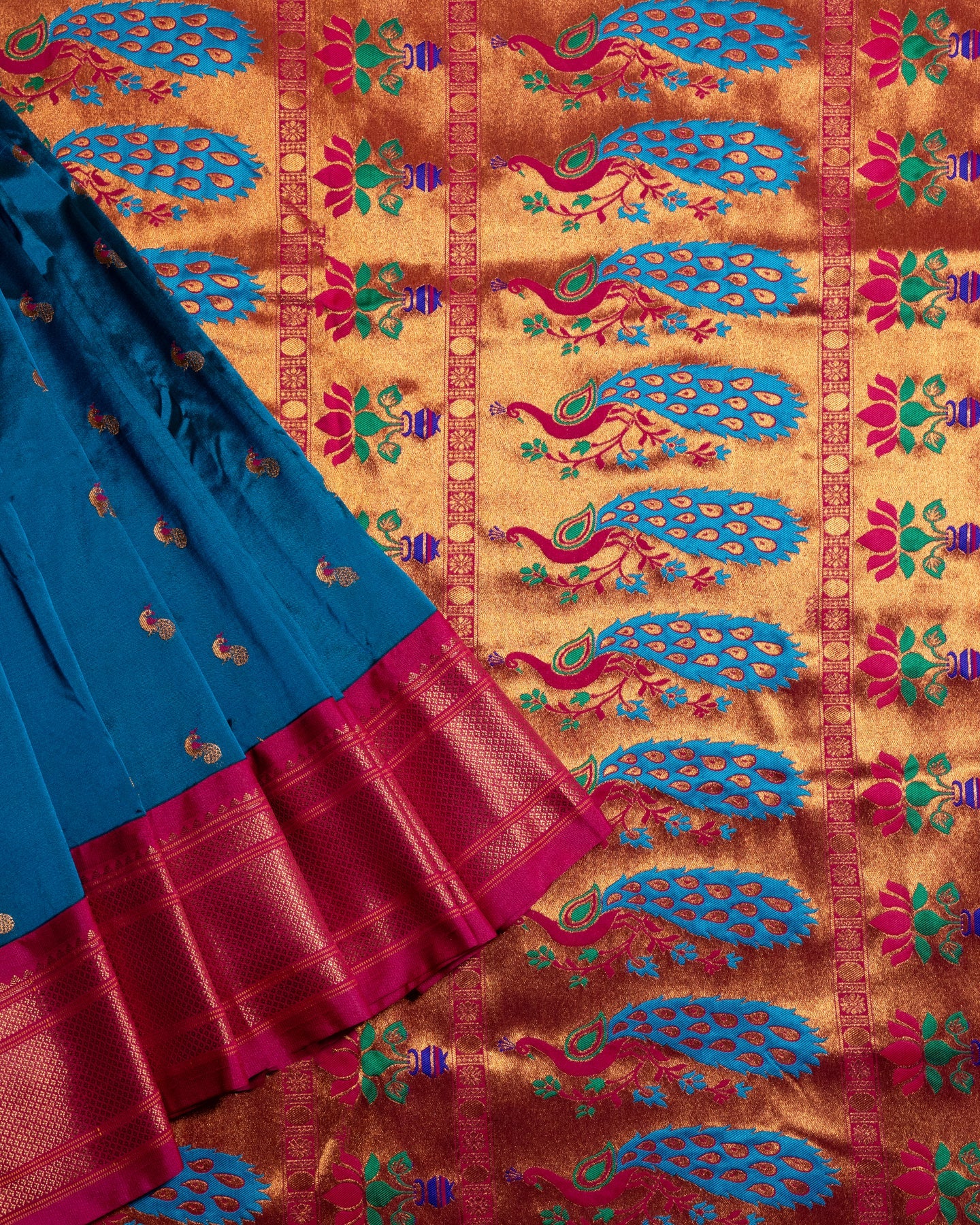The Art of Weaving: Understanding the Motifs in Paithani Sarees

Understanding the Motifs in Paithani Sarees
Paithani sarees are not only renowned for their luxurious silk and intricate craftsmanship but also for their symbolic and artistic motifs. Each motif in a Paithani saree carries a rich heritage and cultural significance, reflecting the creativity and skill of the artisans who bring them to life. Let’s delve into the captivating world of Paithani motifs and their meanings.
1. Peacocks: Grace and Beauty
- The peacock is one of the most iconic motifs in Paithani sarees, often featured on the pallu or borders.
- Symbolism: Representing grace, elegance, and beauty, the peacock motif adds a regal charm to the saree.
- Design Variations: Sometimes, peacocks are paired with intricate floral patterns to create a nature-inspired aesthetic.
2. Lotuses: Purity and Spirituality
- The lotus is a recurring motif in Paithani sarees, often woven in vibrant colors.
- Symbolism: A sacred flower in Indian culture, the lotus signifies purity, spirituality, and divine beauty.
- Placement: Found on the pallu or borders, the lotus motif adds a touch of serenity and elegance to the saree.
3. Parrots: Playfulness and Vibrancy
- Parrots, often woven in pairs, are a popular motif in Paithani designs.
- Symbolism: They represent vibrancy, joy, and the harmony of nature.
- Design Style: Parrots are typically depicted in bright green against contrasting backgrounds, making them stand out.
4. Narali (Coconut): Prosperity and Simplicity
- The narali motif resembles a coconut, a symbol of prosperity and auspiciousness in Indian culture.
- Symbolism: It signifies simplicity and is often associated with traditional rituals and celebrations.
- Usage: This motif is a classic choice for traditional Paithani sarees, particularly for weddings and festivals.
5. Asawali (Creeper): Growth and Nature
- The asawali, or vine creeper, motif features delicate floral patterns intertwined with vines.
- Symbolism: It represents growth, fertility, and the continuity of life.
- Design Details: These motifs are intricately detailed, showcasing the weaver’s meticulous craftsmanship.
6. Bangdi Mor (Peacock in Bangle): Regal Creativity
- The bangdi mor is a distinctive motif featuring a peacock enclosed within a circular frame resembling a bangle.
- Symbolism: It symbolizes artistic creativity and opulence, often reserved for the most luxurious Paithani sarees.
- Design Significance: This motif is a favorite for special occasions due to its grandeur.
7. Geometric Patterns: Precision and Symmetry
- Geometric shapes, such as diamonds and triangles, are a hallmark of Paithani saree borders.
- Symbolism: They represent order, precision, and harmony.
- Design Aesthetic: These patterns complement the more elaborate motifs on the pallu, balancing the overall design.
8. Shikargah (Hunting Scenes): Royal Legacy
- Rare and intricate, the shikargah motif depicts hunting scenes with animals like deer and elephants.
- Symbolism: It reflects the regal and adventurous spirit of the bygone eras.
- Craftsmanship: These motifs require exceptional weaving expertise and are often found in heirloom sarees.
The Significance of Motifs
The motifs in Paithani sarees are more than just decorative elements; they are carriers of cultural stories and symbols of heritage. Each motif is meticulously woven, preserving centuries-old traditions and connecting the wearer to the rich history of India.
Conclusion
The motifs in Paithani sarees exemplify the art of storytelling through weaving. Whether it’s the graceful peacock, the serene lotus, or the intricate geometric patterns, each design holds a special place in the heart of Indian culture. Understanding these motifs allows one to truly appreciate the artistry and legacy of Paithani sarees, making them cherished heirlooms for generations to come.
